A Thorough Examination of Innovative Supplementary Dampers Aimed at Enhancing the Seismic Behavior of Structural Systems
Abstract
:1. Introduction
1.1. Background and Motivation
1.2. Objectives of the Review
1.3. Scope and Limitations
1.4. Paper Organization
2. Overview of Supplementary Damping Systems
2.1. Classification of Damping Devices
2.1.1. Classification by Energy Dissipation Mechanism
2.1.2. Classification by Activation Method
2.1.3. Classification by Functional Characteristics
Integration and Performance Considerations
2.2. Principles of Energy Dissipation Mechanisms
2.2.1. Viscous Damping
2.2.2. Viscoelastic Damping
2.2.3. Friction Damping
2.2.4. Metallic Yield Damping
2.2.5. Tuned Mass Damping
2.3. Brief History and Development of Damping Technologies
2.3.1. Early Developments (1950s–1960s)
2.3.2. Emergence of Seismic Damping Systems (1970s–1980s)
2.3.3. Proliferation and Diversification (1990s–2000s)
2.3.4. Advanced Systems and Integration (2000s–Present)
2.3.5. Key Milestones and Influential Projects
2.3.6. Evolving Design Philosophies
- 1970s–1980s: Focus on life safety and collapse prevention.
- 1990s–2000s: Emergence of performance-based seismic design.
- 2000s–Present: Emphasis on resilience and rapid post-earthquake recovery.
3. Types of Supplementary Dampers and Their Characteristics
3.1. Viscous Dampers
3.1.1. Operating Principle
3.1.2. Mathematical Model
3.1.3. Key Characteristics
3.1.4. Types of Viscous Dampers
- (a)
- Linear viscous dampers: These dampers exhibit a linear force–velocity relationship, making them predictable and easy to model. They are suitable for a wide range of applications due to their consistent behavior across different loading conditions. A prominent example of this type of damper is evident in the cable-stayed Rion-Antirion bridge in Greece (Figure 4), which is situated in a region with significant seismic activity [53].
- (b)
- Nonlinear viscous dampers (Figure 5): These dampers exhibit a nonlinear force–velocity relationship, usually with an exponent α < 1. This nonlinearity allows them to provide higher damping forces at low velocities while limiting forces at high velocities, making them particularly effective in scenarios with varying load intensities [54].
- (c)
3.1.5. Design Considerations
3.1.6. Applications
3.2. Viscoelastic Dampers
3.2.1. Operating Principle
3.2.2. Mathematical Model
3.2.3. Key Characteristics
3.2.4. Types of Viscoelastic Materials
3.2.5. Design Considerations
3.2.6. Applications
3.3. Friction Dampers
3.3.1. Operating Principle
3.3.2. Mathematical Model
3.3.3. Key Characteristics
3.3.4. Types of Friction Dampers
3.3.5. Design Considerations
3.3.6. Applications
3.4. Metallic Yield Dampers
3.4.1. Operating Principle
3.4.2. Mathematical Model
3.4.3. Key Characteristics
3.4.4. Types of Metallic Yield Dampers
3.4.5. Design Considerations
3.4.6. Applications
3.5. Tuned Mass Dampers
3.5.1. Operating Principle
3.5.2. Mathematical Model
3.5.3. Key Characteristics
3.5.4. Types of Tuned Mass Dampers
3.5.5. Design Considerations
3.5.6. Applications
3.6. Base Isolation Systems
3.6.1. Operating Principle
3.6.2. Mathematical Model
3.6.3. Key Characteristics
3.6.4. Types of Base Isolation Systems
3.6.5. Design Considerations
3.6.6. Applications
4. Design Considerations and Implementation Challenges
4.1. Selection and Sizing of Damping Devices
4.2. Integration with Structural Systems
4.3. Code Provisions and Design Guidelines
5. Future Research Directions
6. Discussion
6.1. Cost-Effectiveness and Life-Cycle Considerations
6.2. Strategies and Solutions for Design Implementation Challenges
7. Conclusions and Recommendations
Author Contributions
Funding
Data Availability Statement
Conflicts of Interest
References
- Elias, S.; Matsagar, V. Research developments in vibration control of structures using passive tuned mass dampers. Annu. Rev. Control 2017, 44, 129–156. [Google Scholar] [CrossRef]
- Rahimi, F.; Aghayari, R.; Samali, B. Application of tuned mass dampers for structural vibration control: A state-of-the-art review. Civ. Eng. J. 2020, 6, 1622–1651. [Google Scholar] [CrossRef]
- Kookalani, S.; Shen, D.; Zhu, L.L.; Lindsey, M. An overview of optimal damper placement methods in structures. Iran. J. Sci. Technol. Trans. Civ. Eng. 2022, 46, 1785–1804. [Google Scholar] [CrossRef]
- Yuan, X.; Tian, T.; Ling, H.; Qiu, T.; He, H. A review on structural development of magnetorheological fluid damper. Shock Vib. 2019, 2019, 1498962. [Google Scholar] [CrossRef]
- Stanikzai, M.H.; Elias, S.; Chae, Y. Recent advances in hybrid vibration-control systems. Pract. Period. Struct. Des. Constr. 2022, 27, 03122003. [Google Scholar] [CrossRef]
- Shu, Z.; You, R.; Xie, Y. Viscoelastic Dampers for Vibration Control of Building Structures: A State-of-Art Review. J. Earthq. Eng. 2024, 28, 3558–3585. [Google Scholar] [CrossRef]
- Papagiannopoulos, G.A.; Hatzigeorgiou, G.D.; Beskos, D.E. Design Using Supplemental Dampers. In Seismic Design Methods for Steel Building Structures; Springer: Berlin/Heidelberg, Germany, 2021; pp. 463–508. [Google Scholar]
- Sarwar, W.; Sarwar, R. Vibration control devices for building structures and installation approach: A review. Civ. Environ. Eng. Rep. 2019, 29, 74–100. [Google Scholar] [CrossRef]
- Titirla, M.D. A state-of-the-art review of passive energy dissipation systems in steel braces. Buildings 2023, 13, 851. [Google Scholar] [CrossRef]
- Shobhana, B.B.; Panchal, V.R.; Matsagar, V.A. Research Developments of Eddy Current Dampers for Seismic Vibration Control of Structures. J. Vib. Eng. Technol. 2024, 12, 5953–5971. [Google Scholar] [CrossRef]
- Landi, L.; Lucchi, S.; Diotallevi, P.P. A procedure for the direct determination of the required supplemental damping for the seismic retrofit with viscous dampers. Eng. Struct. 2014, 71, 137–149. [Google Scholar] [CrossRef]
- Lavan, O. Optimal design of viscous dampers and their supporting members for the seismic retrofitting of 3D irregular frame structures. J. Struct. Eng. 2015, 141, 04015026. [Google Scholar] [CrossRef]
- Nuzzo, I.; Losanno, D.; Caterino, N. Seismic design and retrofit of frame structures with hysteretic dampers: A simplified displacement-based procedure. Bull. Earthq. Eng. 2019, 17, 2787–2819. [Google Scholar] [CrossRef]
- Marioni, A. Seismic retrofitting of existing structures. In Anti-Seismic Devices: A Reference Manual for Structural Engineers; Springer International Publishing: Cham, Switzerland, 2024; pp. 145–168. [Google Scholar]
- Marioni, A. Testing Requirements of Anti-seismic Devices and Available Testing Facilities. In Anti-Seismic Devices: A Reference Manual for Structural Engineers; Springer International Publishing: Cham, Switzerland, 2024; pp. 85–109. [Google Scholar]
- Almajhali, K.Y.M. Review on passive energy dissipation devices and techniques of installation for high rise building structures. In Structures; Elsevier: Amsterdam, The Netherlands, 2023; Volume 51, pp. 1019–1029. [Google Scholar]
- Patil, A.Y.; Patil, R.D. A review on seismic analysis of a multi-storied steel building provided with different types of damper and base isolation. Asian J. Civ. Eng. 2024, 25, 3277–3283. [Google Scholar] [CrossRef]
- Arvind, R.; Santhi, M.H. A state of art review on hybrid passive energy dissipating devices. J. Vib. Eng. Technol. 2022, 10, 1931–1954. [Google Scholar] [CrossRef]
- Hu, R.; Hu, S.; Yang, M.; Zhang, Y. Metallic yielding dampers and fluid viscous dampers for vibration control in civil engineering: A review. Int. J. Struct. Stab. Dyn. 2022, 22, 2230006. [Google Scholar] [CrossRef]
- Javadinasab Hormozabad, S.; Zahrai, S.M. Innovative adaptive viscous damper to improve seismic control of structures. J. Vib. Control 2019, 25, 1833–1851. [Google Scholar] [CrossRef]
- Pant, D.R.; Montgomery, M.; Christopoulos, C. Full-scale testing of a viscoelastic coupling damper for high-rise building applications and comparative evaluation of different numerical models. J. Struct. Eng. 2019, 145, 04018242. [Google Scholar] [CrossRef]
- Clemente, P. Seismic isolation: Past, present and the importance of SHM for the future. J. Civ. Struct. Health Monit. 2017, 7, 217–231. [Google Scholar] [CrossRef]
- Ramezani, M.; Bathaei, A.; Ghorbani-Tanha, A.K. Application of artificial neural networks in optimal tuning of tuned mass dampers implemented in high-rise buildings subjected to wind load. Earthq. Eng. Eng. Vib. 2018, 17, 903–915. [Google Scholar] [CrossRef]
- De Domenico, D.; Ricciardi, G. Earthquake protection of structures with nonlinear viscous dampers optimized through an energy-based stochastic approach. Eng. Struct. 2019, 179, 523–539. [Google Scholar] [CrossRef]
- De Domenico, D.; Ricciardi, G.; Takewaki, I. Design strategies of viscous dampers for seismic protection of building structures: A review. Soil Dyn. Earthq. Eng. 2019, 118, 144–165. [Google Scholar] [CrossRef]
- Bajaj, M.; Agrawal, P. A State-of-the-Art Review on Metallic Dampers Based on Different Yielding Mechanism. In Symposium in Earthquake Engineering; Springer Nature: Singapore, 2022; pp. 569–586. [Google Scholar]
- Abdul Aziz, M.; Mohtasim, S.M.; Ahammed, R. State-of-the-art recent developments of large magnetorheological (MR) dampers: A review. Korea-Aust. Rheol. J. 2022, 34, 105–136. [Google Scholar] [CrossRef]
- Morais, J.; de Morais, P.G.; Santos, C.; Costa, A.C.; Candeias, P. Shape memory alloy based dampers for earthquake response mitigation. Procedia Struct. Integr. 2017, 5, 705–712. [Google Scholar] [CrossRef]
- Dutta, S.C.; Majumder, R. Shape memory alloy (SMA) as a potential damper in structural vibration control. In Advances in Manufacturing Engineering and Materials: Proceedings of the International Conference on Manufacturing Engineering and Materials (ICMEM 2018), Nový Smokovec, Slovakia, 18–22 June 2018; Springer International Publishing: Berlin/Heidelberg, Germany, 2019; pp. 485–492. [Google Scholar]
- Sodeyama, H.; Suzuki, K.; Sunakoda, K. Development of large capacity semi-active seismic damper using magneto-rheological fluid. J. Press. Vessel Technol. 2004, 126, 105–109. [Google Scholar] [CrossRef]
- Gallego, A.; Benavent-Climent, A.; Romo-Melo, L. Piezoelectric sensing and non-parametric statistical signal processing for health monitoring of hysteretic dampers used in seismic-resistant structures. Mech. Syst. Signal Process. 2015, 60, 90–105. [Google Scholar] [CrossRef]
- Cortés, G.; Suarez, E.; Gallego, A.; Benavent-Climent, A. Health monitoring of reinforced concrete structures with hysteretic dampers subjected to dynamical loads by means of the acoustic emission energy. Struct. Health Monit. 2019, 18, 1836–1850. [Google Scholar] [CrossRef]
- Tronci, E.M.; De Angelis, M.; Betti, R.; Altomare, V. Vibration-based structural health monitoring of a RC-masonry tower equipped with non-conventional TMD. Eng. Struct. 2020, 224, 111212. [Google Scholar] [CrossRef]
- Yan, G.; Zou, H.X.; Wang, S.; Zhao, L.C.; Wu, Z.Y.; Zhang, W.M. Bio-inspired vibration isolation: Methodology and design. Appl. Mech. Rev. 2021, 73, 020801. [Google Scholar] [CrossRef]
- Mirzai, N.M.; Mansouri, I.; Tezcan, J.; Awoyera, P.O.; Hu, J.W. Estimating optimum parameters of a new SMA damper under different earthquake ground motions. In Structures; Elsevier: Amsterdam, The Netherlands, 2021; Volume 33, pp. 2700–2712. [Google Scholar]
- Baidya, S.; Roy, B.K. Seismic performance enhancement of base isolated RC building incorporating Cu-Al-Be and FNCATB based SMA. In IOP Conference Series: Earth and Environmental Science; IOP Publishing: Bristol, UK, 2024; Volume 1326, No. 1; p. 012018. [Google Scholar] [CrossRef]
- Lee, E.T.; Eun, H.C. Lever-Type Tuned Mass Damper for Alleviating Dynamic Responses. Adv. Civ. Eng. 2019, 2019, 5824972. [Google Scholar] [CrossRef]
- Game, T.; Vos, C.; Morshedi, R.; Gratton, R.; Alonso-Marroquin, F.; Tahmasebinia, F. Full dynamic model of Golden Gate Bridge. In AIP Conference Proceedings; AIP Publishing: Melville, NY, USA, 2016; Volume 1762, No. 1. [Google Scholar] [CrossRef]
- Chen, Y.; Guéguen, P.; Chen, K.H.; Lin, C.J.; Ku, C.S.; Huang, W.G.; Chen, K.C. Dynamic characteristics of TAIPEI 101 skyscraper from rotational and translation seismometers. Bull. Seismol. Soc. Am. 2023, 113, 690–709. [Google Scholar] [CrossRef]
- Lin, S.; Huang, Z.; Lin, S.; Huang, Z. Global Design of Structures. Comp. Des. Struct. Concepts Methodol. 2016, 49–114. [Google Scholar] [CrossRef]
- Ras, A.; Boumechra, N. Seismic energy dissipation study of linear fluid viscous dampers in steel structure design. Alex. Eng. J. 2016, 55, 2821–2832. [Google Scholar] [CrossRef]
- Liu, Y.; Wu, J.; Donà, M. Effectiveness of fluid-viscous dampers for improved seismic performance of inter-storey isolated buildings. Eng. Struct. 2018, 169, 276–292. [Google Scholar] [CrossRef]
- Scozzese, F.; Gioiella, L.; Dall’Asta, A.; Ragni, L.; Tubaldi, E. Influence of viscous dampers ultimate capacity on the seismic reliability of building structures. Struct. Saf. 2021, 91, 102096. [Google Scholar] [CrossRef]
- Halperin, I.; Ribakov, Y.; Agranovich, G. Optimal viscous dampers gains for structures subjected to earthquakes. Struct. Control Health Monit. 2016, 23, 458–469. [Google Scholar] [CrossRef]
- Kaleybar, R.S.; Tehrani, P. Effects of using different arrangements and types of viscous dampers on seismic performance of intermediate steel moment frames in comparison with different passive dampers. In Structures; Elsevier: Amsterdam, The Netherlands, 2021; Volume 33, pp. 3382–3396. [Google Scholar]
- Kazemi, F.; Mohebi, B.; Yakhchalian, M. Enhancing the seismic performance of adjacent pounding structures using viscous dampers. In Proceedings of the 16th European Conference on Earthquake Engineering (16ECEE), Thessaloniki, Greece, 18–21 June 2018; pp. 18–21. [Google Scholar]
- Altieri, D.; Tubaldi, E.; De Angelis, M.; Patelli, E.; Dall’Asta, A. Reliability-based optimal design of nonlinear viscous dampers for the seismic protection of structural systems. Bull. Earthq. Eng. 2018, 16, 963–982. [Google Scholar] [CrossRef]
- Altieri, D.; Tubaldi, E.; Patelli, E.; Dall’Asta, A. Assessment of optimal design methods of viscous dampers. Procedia Eng. 2017, 199, 1152–1157. [Google Scholar] [CrossRef]
- Palermo, M.; Silvestri, S.; Landi, L.; Gasparini, G.; Trombetti, T. A “direct five-step procedure” for the preliminary seismic design of buildings with added viscous dampers. Eng. Struct. 2018, 173, 933–950. [Google Scholar] [CrossRef]
- Brando, G.; D’Agostino, F.; De Matteis, G. Seismic performance of MR frames protected by viscous or hysteretic dampers. Struct. Des. Tall Spec. Build. 2015, 24, 653–671. [Google Scholar] [CrossRef]
- Hatzigeorgiou, G.D.; Papagiannopoulos, G.A. Inelastic velocity ratio. Earthq. Eng. Struct. Dyn. 2013, 41, 2025–2041. [Google Scholar] [CrossRef]
- Hatzigeorgiou, G.D.; Pnevmatikos, N.G. Maximum damping forces for structures with viscous dampers under near-source earthquakes. Eng. Struct. 2014, 68, 1–13. [Google Scholar] [CrossRef]
- Khedmatgozar Dolati, S.S.; Mehrabi, A.; Khedmatgozar Dolati, S.S. Application of Viscous Damper and Laminated Rubber Bearing Pads for Bridges in Seismic Regions. Metals 2021, 11, 1666. [Google Scholar] [CrossRef]
- Bin Mohd Ali, M.R.; Hejazi, F. Development of the Viscous Plane Damper Applicable in Limited Space within Structures Subjected to Dynamic Loads. Appl. Sci. 2024, 14, 9029. [Google Scholar] [CrossRef]
- Belbachir, A.; Benanane, A.; Ouazir, A.; Harrat, Z.R.; Hadzima-Nyarko, M.; Radu, D.; Işık, E.; Louhibi, Z.S.M.; Amziane, S. Enhancing the Seismic Response of Residential RC Buildings with an Innovative Base Isolation Technique. Sustainability 2023, 15, 11624. [Google Scholar] [CrossRef]
- Zoccolini, L.; Bruschi, E.; Cattaneo, S.; Quaglini, V. Current Trends in Fluid Viscous Dampers with Semi-Active and Adaptive Behavior. Appl. Sci. 2023, 13, 10358. [Google Scholar] [CrossRef]
- Shedbale, N.; Muley, P.V. Review on viscoelastic materials used in viscoelastic dampers. Int. Res. J. Eng. Technol. 2017, 1, 3375–3381. [Google Scholar]
- Tchamo, J.M.; Zhou, Y. An alternative practical design method for structures with viscoelastic dampers. Earthq. Eng. Eng. Vib. 2018, 17, 459–473. [Google Scholar] [CrossRef]
- Wang, S.J.; Zhang, Q.Y.; Yu, C.H. Effectiveness of damaged viscoelastic dampers in seismic protection of structures under main shocks and aftershocks. Eng. Struct. 2021, 242, 112424. [Google Scholar] [CrossRef]
- Zhou, Y.; Aguaguiña, M.; Beskos, D.E.; Gong, S. A displacement-based seismic design method for building structures with nonlinear viscoelastic dampers. Bull. Earthq. Eng. 2021, 19, 4535–4585. [Google Scholar] [CrossRef]
- Lin, W.C.; Yu, C.H.; Tsai, M.A.; Chang, Y.W.; Peng, S.K.; Wang, S.J. Hysteretic behavior of viscoelastic dampers subjected to damage during seismic loading. J. Build. Eng. 2022, 53, 104538. [Google Scholar] [CrossRef]
- Li, Y.; Geng, F.; Ding, Y.; Wang, L. Influence of mild steel damper design parameters on energy dissipation performance of low-damage self-centering precast concrete frame connections. Soil Dyn. Earthq. Eng. 2021, 144, 106696. [Google Scholar] [CrossRef]
- Ge, X.; Azim, I.; Li, C.; Gong, J.; Liu, M.; Zhao, C. Seismic responses of structure with six-element generalized model viscoelastic dampers. Soil Dyn. Earthq. Eng. 2023, 164, 107610. [Google Scholar] [CrossRef]
- Guo, J.W.W.; Daniel, Y.; Montgomery, M.; Christopoulos, C. Thermal-mechanical model for predicting the wind and seismic response of viscoelastic dampers. J. Eng. Mech. 2016, 142, 04016067. [Google Scholar] [CrossRef]
- Gong, S.; Zhou, Y.; Ge, P. Seismic analysis for tall and irregular temple buildings: A case study of strong nonlinear viscoelastic dampers. Struct. Des. Tall Spec. Build. 2017, 26, e1352. [Google Scholar] [CrossRef]
- Javidan, M.M.; Assefa, J.D.; Kim, J. Seismic retrofit of low-rise structures using rotational viscoelastic dampers. In Structures; Elsevier: Amsterdam, The Netherlands, 2023; Volume 58, p. 105403. [Google Scholar]
- Hao, L.; Liu, M.; Li, J.; Tan, P.; Wu, D. Multi-performance oriented seismic design of viscoelastic dampers for structural retrofitting. J. Build. Eng. 2024, 86, 108657. [Google Scholar] [CrossRef]
- Xie, L.; Zhang, L.; Pan, C.; Zhang, R.; Chen, T. Uniform damping ratio-based design method for seismic retrofitting of elastoplastic RC structures using viscoelastic dampers. Soil Dyn. Earthq. Eng. 2020, 128, 105866. [Google Scholar] [CrossRef]
- Parvin Darabad, Y.; Hassanpour Yasaghi, A.; Khodaei, B.; Zarei, R. Distribution of Seismic Damage in Steel Buildings Component Equipped by Viscoelastic Dampers against Far-Field Earthquake. Shock Vib. 2021, 2021, 8291173. [Google Scholar] [CrossRef]
- El Ouni, M.H.; Abdeddaim, M.; Elias, S.; Kahla, N.B. Review of Vibration Control Strategies of High-Rise Buildings. Sensors 2022, 22, 8581. [Google Scholar] [CrossRef]
- Sarjou, P.H.; Shabakhty, N. Effect of the improved pall friction damper on the seismic response of steel frames. Eng. Technol. Appl. Sci. Res. 2017, 7, 1833–1837. [Google Scholar] [CrossRef]
- Wu, B.; Zhang, J.; Williams, M.S.; Ou, J. Hysteretic behavior of improved Pall-typed frictional dampers. Eng. Struct. 2005, 27, 1258–1267. [Google Scholar] [CrossRef]
- Chan, R.W.; Tang, W. Serviceability conditions of friction dampers for seismic risk mitigations. In Structures; Elsevier: Amsterdam, The Netherlands, 2022; Volume 35, pp. 500–510. [Google Scholar]
- Jarrahi, H.; Asadi, A.; Khatibinia, M.; Etedali, S. Optimal design of rotational friction dampers for improving seismic performance of inelastic structures. J. Build. Eng. 2020, 27, 100960. [Google Scholar] [CrossRef]
- Ontiveros-Pérez, S.P.; Miguel, L.F.F.; Riera, J.D. Reliability-based optimum design of passive friction dampers in buildings in seismic regions. Eng. Struct. 2019, 190, 276–284. [Google Scholar] [CrossRef]
- Moghaddam, H.; Afzalinia, F.; Hajirasouliha, I. Optimal distribution of friction dampers to improve the seismic performance of steel moment resisting frames. In Structures; Elsevier: Amsterdam, The Netherlands, 2022; Volume 37, pp. 624–644. [Google Scholar]
- Montuori, R.; Nastri, E.; Piluso, V. Theory of plastic mechanism control for the seismic design of braced frames equipped with friction dampers. Mech. Res. Commun. 2014, 58, 112–123. [Google Scholar] [CrossRef]
- Huang, L.; Clayton, P.M.; Zhou, Z. Seismic design and performance of self-centering precast concrete frames with variable friction dampers. Eng. Struct. 2021, 245, 112863. [Google Scholar] [CrossRef]
- Kim, J.; Kim, S. Performance-based seismic design of staggered truss frames with friction dampers. Thin-Walled Struct. 2017, 111, 197–209. [Google Scholar] [CrossRef]
- Armaly, M.; Damerji, H.; Hallal, J.; Fakih, M. Effectiveness of friction dampers on the seismic behavior of high rise building VS shear wall system. Eng. Rep. 2019, 1, e12075. [Google Scholar] [CrossRef]
- Shirkhani, A.; Azar, B.F.; Basim, M.C. Seismic loss assessment of steel structures equipped with rotational friction dampers subjected to intensifying dynamic excitations. Eng. Struct. 2021, 238, 112233. [Google Scholar] [CrossRef]
- Gharagoz, M.M.; Noureldin, M.; Kim, J. Machine learning-based design of a seismic retrofit frame with spring-rotational friction dampers. Eng. Struct. 2023, 292, 116053. [Google Scholar] [CrossRef]
- Mualla, I.; Belev, B. Analysis, design and applications of rotational friction dampers for seismic protection. Czas. Inżynierii Lądowej Sr. I Archit. 2015, 62, 335–346. [Google Scholar] [CrossRef]
- Pnevmatikos, N.; Hatzigeorgiou, G. Seismic Design of Steel Frames Equipped by Control Devices. Open Constr. Build. Technol. J. 2014, 8, 300–309. [Google Scholar] [CrossRef]
- Feng, R.; Xu, W.; Wang, S.; Du, D.; Xie, L.; Miao, Q. Seismic response of two-storey steel frame equipped with metallic yielding and viscous dampers under far-and near-field earthquakes: Shaking table tests and numerical investigations. In Structures; Elsevier: Amsterdam, The Netherlands, 2023; Volume 58, p. 105538. [Google Scholar]
- Kothapalli, N.K.; Chidambaram, R.S.; Agarwal, P. Experimental Evaluation of Steel Bracings and Metallic Yield Damper as Retrofit Techniques for Severely Damaged RC Building Frames. J. Earthq. Eng. 2023, 27, 3564–3587. [Google Scholar] [CrossRef]
- Wang, H.; Shen, W.; Zhu, H.; Wei, W.; Kong, F.; Zhu, S. Performance enhancement of FPS-isolated buildings using an inerter-based damper: Stochastic seismic analysis and optimization. Mech. Syst. Signal Process. 2022, 177, 109237. [Google Scholar] [CrossRef]
- Mahjoubi, S.; Maleki, S. Seismic performance assessment of steel frames equipped with a novel passive damper using a new damper performance index. Struct. Control Health Monit. 2015, 22, 774–797. [Google Scholar] [CrossRef]
- Hossain, M.R.; Ashraf, M.; Padgett, J.E. Risk-based seismic performance assessment of Yielding Shear Panel Device. Eng. Struct. 2013, 56, 1570–1579. [Google Scholar] [CrossRef]
- Mahjoubi, S.; Maleki, S. Seismic performance evaluation and design of steel structures equipped with dual-pipe dampers. J. Constr. Steel Res. 2016, 122, 25–39. [Google Scholar] [CrossRef]
- Mohammadi, R.K.; Nasri, A.; Ghaffary, A. TADAS dampers in very large deformations. Int. J. Steel Struct. 2017, 17, 515–524. [Google Scholar] [CrossRef]
- Li, Q.Q.; Xu, Z.D.; Dong, Y.R.; He, Z.H.; Zhu, C.; Lu, Y. Effects of mechanical nonlinearity of viscoelastic dampers on the seismic performance of viscoelasticlly damped structures. Soil Dyn. Earthq. Eng. 2021, 150, 106936. [Google Scholar] [CrossRef]
- Youssef, A.A.; Esfahani, M.R.; Zareian, M.S. Experimental evaluation of post-tensioned hybrid coupled shear wall system with TADAS steel dampers at the beam-wall interface. In Structures; Elsevier: Amsterdam, The Netherlands, 2023; Volume 53, pp. 1283–1299. [Google Scholar]
- Yousefi, M.; Nassira, Y.; Ghamari, A. Performance of a New Model of Rectangular Damper in Diagonal Concentric Brace. Iran. J. Sci. Technol. Trans. Civ. Eng. 2022, 46, 2235–2248. [Google Scholar] [CrossRef]
- Li, Y.; Geng, F.; Ding, Y.; Pang, R. Influence of the pinching behavior of the damper on seismic performance of low-damage self-centering precast concrete frames. Soil Dyn. Earthq. Eng. 2024, 185, 108888. [Google Scholar] [CrossRef]
- Farajiani, F.; Elyasigorji, F.; Elyasigorji, S.; Moradi, M.J.; Farhangi, V. Effect of U-Shaped Metallic Dampers on the Seismic Performance of Steel Structures based on Endurance-Time Analysis. Buildings 2024, 14, 1368. [Google Scholar] [CrossRef]
- Weber, F.; Borchsenius, F.; Distl, J.; Braun, C. Performance of Numerically Optimized Tuned Mass Damper with Inerter (TMDI). Appl. Sci. 2022, 12, 6204. [Google Scholar] [CrossRef]
- Salvi, J.; Rizzi, E. Optimum tuning of Tuned Mass Dampers for frame structures under earthquake excitation. Struct. Control Health Monit. 2015, 22, 707–725. [Google Scholar] [CrossRef]
- Bagheri, S.; Rahmani-Dabbagh, V. Seismic response control with inelastic tuned mass dampers. Eng. Struct. 2018, 172, 712–722. [Google Scholar] [CrossRef]
- Boccamazzo, A.; Carboni, B.; Quaranta, G.; Lacarbonara, W. Seismic effectiveness of hysteretic tuned mass dampers for inelastic structures. Eng. Struct. 2020, 216, 110591. [Google Scholar] [CrossRef]
- Salvi, J.; Pioldi, F.; Rizzi, E. Optimum tuned mass dampers under seismic soil-structure interaction. Soil Dyn. Earthq. Eng. 2018, 114, 576–597. [Google Scholar] [CrossRef]
- Kayabekir, A.E.; Bekdaş, G.; Nigdeli, S.M.; Geem, Z.W. Optimum design of PID controlled active tuned mass damper via modified harmony search. Appl. Sci. 2020, 10, 2976. [Google Scholar] [CrossRef]
- Kayabekir, A.E.; Nigdeli, S.M.; Bekdaş, G. Active Tuned Mass Dampers for Control of Seismic Structures. WSEAS Trans. Comput. 2020, 19, 122–128. [Google Scholar] [CrossRef]
- Lu, Z.; Chen, X.; Zhang, D.; Dai, K. Experimental and analytical study on the performance of particle tuned mass dampers under seismic excitation. Earthq. Eng. Struct. Dyn. 2017, 46, 697–714. [Google Scholar] [CrossRef]
- Araz, O. Optimum passive tuned mass damper systems for main structures under harmonic excitation. J. Eng. Sci. Des. 2021, 9, 1062–1071. [Google Scholar] [CrossRef]
- Araz, O. Optimum three-element tuned mass damper for damped main structures under ground acceleration. El-Cezeri J. Sci. Eng. 2021, 8, 1264–1271. [Google Scholar] [CrossRef]
- Caicedo, D.; Lara-Valencia, L.; Blandon, J.; Graciano, C. Seismic response of high-rise buildings through metaheuristic-based optimization using tuned mass dampers and tuned mass dampers inerter. J. Build. Eng. 2021, 34, 101927. [Google Scholar] [CrossRef]
- Radmard Rahmani, H.; Könke, C. Seismic control of tall buildings using distributed multiple tuned mass dampers. Adv. Civ. Eng. 2019, 2019, 6480384. [Google Scholar] [CrossRef]
- Khazaei, M.; Vahdani, R.; Kheyroddin, A. Optimal location of multiple tuned mass dampers in regular and irregular tall steel buildings plan. Shock Vib. 2020, 2020, 9072637. [Google Scholar] [CrossRef]
- Kaveh, A.; Mohammadi, S.; Hosseini, O.K.; Keyhani, A.; Kalatjari, V.R. Optimum parameters of tuned mass dampers for seismic applications using charged system search. Iranian Journal of Science and Technology. Trans. Civ. Eng. 2015, 39, 21. [Google Scholar]
- Kahya, V.; Araz, O. A sequential approach based design of multiple tuned mass dampers under harmonic excitation. Sigma J. Eng. Nat. Sci. 2019, 37, 225–239. [Google Scholar]
- Stanikzai, M.H.; Elias, S.; Matsagar, V.A.; Jain, A.K. Seismic response control of base-isolated buildings using multiple tuned mass dampers. Struct. Des. Tall Spec. Build. 2019, 28, e1576. [Google Scholar] [CrossRef]
- Araz, O.; Kahya, V. Optimization of non-traditional tuned mass damper for damped structures under harmonic excitation. UUJFE 2021, 26, 1021–1034. [Google Scholar] [CrossRef]
- Araz, O.; Kahya, V. Design of series tuned mass dampers for seismic control of structures using simulated annealing algorithm. Arch. Appl. Mech. 2021, 91, 4343–4359. [Google Scholar] [CrossRef]
- Matin, A.; Elias, S.; Matsagar, V. Distributed multiple tuned mass dampers for seismic response control in bridges. Proc. Inst. Civ. Eng.-Struct. Build. 2020, 173, 217–234. [Google Scholar] [CrossRef]
- Shahraki, M.A.; Kamgar, R.; Heidarzadeh, H. Damage-based design of multiple tuned mass dampers to improve the seismic performance of steel frame structures. Soil Dyn. Earthq. Eng. 2023, 173, 108062. [Google Scholar] [CrossRef]
- Vellar, L.S.; Ontiveros-Pérez, S.P.; Miguel, L.F.F.; Fadel Miguel, L.F. Robust optimum design of multiple tuned mass dampers for vibration control in buildings subjected to seismic excitation. Shock Vib. 2019, 2019, 9273714. [Google Scholar] [CrossRef]
- Ozturk, B.; Cetin, H.; Aydin, E. Optimum vertical location and design of multiple tuned mass dampers under seismic excitations. In Structures; Elsevier: Amsterdam, The Netherlands, 2022; Volume 41, pp. 1141–1163. [Google Scholar]
- Araz, O.; Elias, S.; Kablan, F. Seismic-induced vibration control of a multi-story building with double tuned mass dampers considering soil-structure interaction. Soil Dyn. Earthq. Eng. 2023, 166, 107765. [Google Scholar] [CrossRef]
- Liu, C.; Chen, L.; Lee, H.P.; Yang, Y.; Zhang, X. A review of the inerter and inerter-based vibration isolation: Theory, devices, and applications. J. Frankl. Inst. 2022, 359, 7677–7707, ISSN 0016-0032. [Google Scholar] [CrossRef]
- Nakamura, Y.; Okada, K. Review on seismic isolation and response control methods of buildings in Japan. Geoenvironmental Disasters 2019, 6, 7. [Google Scholar] [CrossRef]
- Luo, C.; Mu, H.; Wang, H.; Guo, X.; Liu, D.; Feng, H. Study on the seismic mitigation effects of inerter isolated storage tanks. Soil Dyn. Earthq. Eng. 2023, 173, 108140. [Google Scholar] [CrossRef]
- Öncü-Davas, S.; Alhan, C. Reliability of semi-active seismic isolation under near-fault earthquakes. Mech. Syst. Signal Process. 2019, 114, 146–164. [Google Scholar] [CrossRef]
- Rakicevic, Z.; Bogdanovic, A.; Farsangi, E.N.; Sivandi-Pour, A. A hybrid seismic isolation system toward more resilient structures: Shaking table experiment and fragility analysis. J. Build. Eng. 2021, 38, 102194. [Google Scholar] [CrossRef]
- Wolff, E.D.; Ipek, C.; Constantinou, M.C.; Tapan, M. Effect of viscous damping devices on the response of seismically isolated structures. Earthq. Eng. Struct. Dyn. 2015, 44, 185–198. [Google Scholar] [CrossRef]
- Durseneva, N.V.; Indeykin, A.V.; Kuznetsova, I.O.; Uzdin, A.M.; Fedorova, M.Y. Peculiarities of calculating bridges with seismic isolation including spherical bearings and hydraulic dampers in Russia. J. Civ. Eng. Archtecture 2015, 9, 401–409. [Google Scholar]
- Xie, Y.; Zhang, J. Design and optimization of seismic isolation and damping devices for highway bridges based on probabilistic repair cost ratio. J. Struct. Eng. 2018, 144, 04018125. [Google Scholar] [CrossRef]
- Ismail, M. Inner pounding control of the RNC isolator and its impact on seismic isolation efficiency under near-fault earthquakes. Eng. Struct. 2015, 86, 99–121. [Google Scholar] [CrossRef]
- Milanchian, R.; Hosseini, M. Torsional response reduction of plan-asymmetric vertical seismic isolation by appropriate distribution of viscous and viscoelastic dampers. In Structures; Elsevier: Amsterdam, The Netherlands, 2020; Volume 27, pp. 962–974. [Google Scholar]
- Chen, X.; Xiong, J. Seismic resilient design with base isolation device using friction pendulum bearing and viscous damper. Soil Dyn. Earthq. Eng. 2022, 153, 107073. [Google Scholar] [CrossRef]
- Tai, Y.J.; Huang, Z.W.; Chen, C.; Hua, X.G.; Chen, Z.Q. Geometrically nonlinearity analysis and performance evaluation of tuned inerter dampers for multidirectional seismic isolation. Mech. Syst. Signal Process. 2022, 168, 108681. [Google Scholar] [CrossRef]
- Lavan, O.; Amir, O. Simultaneous topology and sizing optimization of viscous dampers in seismic retrofitting of 3D irregular frame structures. Earthq. Eng. Struct. Dyn. 2014, 43, 1325–1342. [Google Scholar] [CrossRef]
- Güllü, A.; Körpeoğlu, S.G.; Selek Kılıçarslan, E.S. Multi-objective optimal sizing of energy dissipative steel cushions for longitudinal loading. Struct. Multidiscip. Optim. 2021, 63, 2955–2967. [Google Scholar] [CrossRef]
- Nabid, N.; Hajirasouliha, I.; Petkovski, M. Adaptive low computational cost optimisation method for Performance-based seismic design of friction dampers. Eng. Struct. 2019, 198, 109549. [Google Scholar] [CrossRef]
- Wang, S.; Mahin, S.A. High-performance computer-aided optimization of viscous dampers for improving the seismic performance of a tall building. Soil Dyn. Earthq. Eng. 2018, 113, 454–461. [Google Scholar] [CrossRef]
- Ruiz, R.; Taflanidis, A.A.; Giaralis, A.; Lopez-Garcia, D. Risk-informed optimization of the tuned mass-damper-inerter (TMDI) for the seismic protection of multi-storey building structures. Eng. Struct. 2018, 177, 836–850. [Google Scholar] [CrossRef]
- D’Agostino, D.; Faiella, D.; Febbraro, E.; Mele, E.; Minichiello, F.; Trimarco, J. Steel exoskeletons for integrated seismic/energy retrofit of existing buildings-General framework and case study. J. Build. Eng. 2024, 83, 108413. [Google Scholar] [CrossRef]
- Labò, S.; Belleri, A.; Marini, A. Seismic design spectra considering nonlinear connections between the existing building and the retrofit system. Eng. Struct. 2024, 308, 117937. [Google Scholar] [CrossRef]
- Zhou, W.; Xiong, L.; Jiang, L.; Feng, Y.; Wu, L.; Peng, K. Optimizing seismic fragility assessments for high-speed railway track bridges: A novel multi-parameter methodology and intensity measure selection. Mech. Based Des. Struct. Mach. 2024, 52, 7159–7179. [Google Scholar] [CrossRef]
- Gomez, F.; Fermandois, G.A.; Spencer Jr, B.F. Optimal design of nonlinear energy sinks for mitigation of seismic response on structural systems. Eng. Struct. 2021, 232, 111756. [Google Scholar] [CrossRef]
- Soroushian, A. Performance of a time integration acceleration technique applied to seismic analysis of non-classically damped structural dynamics. Iran. J. Sci. Technol. Trans. Civ. Eng. 2022, 46, 1281–1300. [Google Scholar] [CrossRef]
- Parajuli, S.; Pokhrel, P.; Suwal, R. A comprehensive study of viscous damper configurations and vertical damping coefficient distributions for enhanced performance in reinforced concrete structures. Asian J. Civ. Eng. 2024, 25, 1043–1059. [Google Scholar] [CrossRef]
- ASCE/SEI 7-22; Minimum Design Loads and Associated Criteria for Buildings and Other Structures. American Society of Civil Engineers: Reston, VA, USA, 2021.
- Anajafi, H.; Medina, R.A. Comparison of the seismic performance of a partial mass isolation technique with conventional TMD and base-isolation systems under broad-band and narrow-band excitations. Eng. Struct. 2018, 158, 110–123. [Google Scholar] [CrossRef]
- Tabar, A.M.; De Domenico, D. Nonlinear response spectrum analysis of structures equipped with nonlinear power law viscous dampers. Eng. Struct. 2020, 219, 110857. [Google Scholar] [CrossRef]
- Seong-Ha, J.E.O.N.; Ji-Hun, P.A.R.K.; Tae-Woong, H.A. Seismic Design of Steel Moment-Resisting Frames with Damping Systems in Accordance with KBC 2016. Appl. Sci. 2019, 9, 2317. [Google Scholar] [CrossRef]
- Quintana, H.C.; Petkovski, M. Optimum performance of structural control with friction dampers. Eng. Struct. 2018, 172, 154–162. [Google Scholar] [CrossRef]
- Guo, T.; Xu, J.; Xu, W.; Di, Z. Seismic upgrade of existing buildings with fluid viscous dampers: Design methodologies and case study. J. Perform. Constr. Facil. 2015, 29, 04014175. [Google Scholar] [CrossRef]
- Xie, W.; Hua, Y. Structural Vibration Comfort: A Review of Recent Developments. Buildings 2024, 14, 1592. [Google Scholar] [CrossRef]
- Hao, H.; Bi, K.; Chen, W.; Pham, T.M.; Li, J. Towards next generation design of sustainable, durable, multi-hazard resistant, resilient, and smart civil engineering structures. Eng. Struct. 2023, 277, 115477. [Google Scholar] [CrossRef]
- Wu, X.; Han, J.; Cui, H.; Li, T.; Bai, X.; He, Y.; Liu, N. A Comparative Review of Recent Research Progress in Prefabricated Buildings in China and Other Countries. Buildings 2024, 14, 1062. [Google Scholar] [CrossRef]
- Kang, J.D.; Tagawa, H. Experimental evaluation of dynamic characteristics of seesaw energy dissipation system for vibration control of structures. Earthq. Eng. Struct. Dyn. 2014, 43, 1889–1895. [Google Scholar] [CrossRef]
- Tagawa, H.; Yamanishi, T.; Takaki, A.; Chan, R.W. Cyclic behavior of seesaw energy dissipation system with steel slit dampers. J. Constr. Steel Res. 2016, 117, 24–34. [Google Scholar] [CrossRef]
- Kang, J.D.; Tagawa, H. Comparison between experimental and analytical results for seesaw energy dissipation systems using fluid viscous dampers. Earthq. Eng. Eng. Vib. 2016, 15, 79–90. [Google Scholar] [CrossRef]
- Katsimpini, P.S.; Papagiannopoulos, G.A.; Sfakianakis, M.G. On the seismic response and damping capacity of low-rise plane steel frames with seesaw system. Soil Dyn. Earthq. Eng. 2018, 107, 407–416. [Google Scholar] [CrossRef]
- Katsimpini, P.S.; Papagiannopoulos, G.A.; Karabalis, D.L. Seismic response of steel structures equipped with the seesaw system. ce/papers 2019, 3, 487–492. [Google Scholar] [CrossRef]
- Katsimpini, P.S.; Askouni, P.K.; Papagiannopoulos, G.A.; Karabalis, D.L. Seismic drift response of seesaw-braced and buckling-restrained braced steel structures: A comparison study. Soil Dyn. Earthq. Eng. 2020, 129, 105925. [Google Scholar] [CrossRef]
- Katsimpini, P.S.; Papagiannopoulos, G.A.; Askouni, P.K.; Karabalis, D.L. Seismic response of low-rise 3-D steel structures equipped with the seesaw system. Soil Dyn. Earthq. Eng. 2020, 128, 105877. [Google Scholar] [CrossRef]
- Beskos, D.; Katsimpini, P.; Papagiannopoulos, G.; Karabalis, D.; Hatzigeorgiou, G. Seismic performance and design details of low-rise steel structures equipped with the seesaw system. In Proceedings of the 17th World Conference on Earthquake Engineering, Sendai, Japan, 13–18 September 2021; Volume 27. [Google Scholar]
- Katsimpini, P.S.; Papagiannopoulos, G.A. Effectiveness of the seesaw system as a means of seismic upgrading in older, non-ductile reinforced concrete buildings. Vibration 2023, 6, 102–112. [Google Scholar] [CrossRef]
- Katsimpini, P.; Papagiannopoulos, G.; Hatzigeorgiou, G. Seismic response of elevated RC tanks equipped with the seesaw system. Soil Dyn. Earthq. Eng. 2023, 173, 108114. [Google Scholar] [CrossRef]
- Katsimpini, P.; Papagiannopoulos, G.; Hatzigeorgiou, G. Seismic response of elevated steel tanks equipped with the seesaw system. Bull. Earthq. Eng. 2024, 22, 1253–1274. [Google Scholar] [CrossRef]
- 7Ocak, A.; Bekdaş, G.; Nigdeli, S.M.; Kim, S.; Geem, Z.W. Optimization of tuned liquid damper including different liquids for lateral displacement control of single and multi-story structures. Buildings 2022, 12, 377. [Google Scholar] [CrossRef]
- Yan, J.K.; Zheng, Z.; Zhou, Y.C.; Lin, J.R.; Deng, Y.C.; Lu, X.Z. Recent Research Progress in Intelligent Construction: A Comparison between China and Developed Countries. Buildings 2023, 13, 1329. [Google Scholar] [CrossRef]
- Thiebaud, F.; Ben Zineb, T. Structural analysis of the dynamic response of a shape memory alloy based damper. J. Vib. Control 2024. [Google Scholar] [CrossRef]
- Kang, X.; Tang, J.; Xia, G.; Wei, J.; Zhang, F.; Sheng, Z. Design, optimization, and application of nonlinear energy sink in energy harvesting device. Int. J. Energy Res. 2024, 2024, 2811428. [Google Scholar] [CrossRef]
- Matta, E. Lifecycle cost effectiveness of translational and pendulum tuned mass dampers for the seismic mitigation of building structures. Int. J. Lifecycle Perform. Eng. 2018, 2, 162–188. [Google Scholar] [CrossRef]
- Matta, E. Seismic effectiveness and robustness of tuned mass dampers versus nonlinear energy sinks in a lifecycle cost perspective. Bull. Earthq. Eng. 2021, 19, 513–551. [Google Scholar] [CrossRef]
- Kolour, N.A.; Basim, M.C.; Chenaghlou, M. Multi-objective optimum design of nonlinear viscous dampers in steel structures based on life cycle cost. Structures 2021, 34, 3776–3788. [Google Scholar] [CrossRef]
- Gallo, W.W.C.; Gabbianelli, G.; Monteiro, R. Assessment of multi-criteria evaluation procedures for identification of optimal seismic retrofitting strategies for existing RC buildings. J. Earthq. Eng. 2022, 26, 5539–5572. [Google Scholar] [CrossRef]
- Gur, S.; Mishra, S.K.; Roy, K. Stochastic seismic response of building with super-elastic damper. Mech. Syst. Signal Process. 2016, 72, 642–659. [Google Scholar] [CrossRef]
- Panda, J.; Singh, V.; Jain, R.; Matsagar, V. Seismic performance assessment and benefit-cost analysis of mid-rise reinforced concrete base-isolated building using double-curvature friction pendulum bearings. Struct. Infrastruct. Eng. 2023, 1–15. [Google Scholar] [CrossRef]
- Hu, S.; Koetaka, Y.; Chen, Z.P.; Zhu, S.; Alam, M.S. Hybrid self-centering braces with NiTi-SMA U-shaped and frequency-dependent viscoelastic dampers for structural and nonstructural damage control. Eng. Struct. 2024, 308, 117920. [Google Scholar] [CrossRef]
- Zhang, R.; Hu, S. Optimal design of self-centering braced frames with limited self-centering braces. J. Build. Eng. 2024, 88, 109201. [Google Scholar] [CrossRef]
- Noureldin, M.; Gharagoz, M.M.; Kim, J. Seismic retrofit of steel structures with re-centering friction devices using genetic algorithm and artificial neural network. Steel Compos. Struct. 2023, 47, 167–184. [Google Scholar]
- Shehata, M.; Abdelnaeem, M.; Mokhiamar, O. Integrated multiple criteria decision-making framework for ranking Pareto optimal solutions of the multiobjective optimization problem of tuned mass dampers. Ocean Eng. 2023, 278, 114440. [Google Scholar] [CrossRef]
- Caterino, N.; Nuzzo, I.; Ianniello, A.; Varchetta, G.; Cosenza, E. A BIM-based decision-making framework for optimal seismic retrofit of existing buildings. Eng. Struct. 2021, 242, 112544. [Google Scholar] [CrossRef]
- Wen, J.; Han, Q.; Xie, Y.; Du, X.; Zhang, J. Performance-based seismic design and optimization of damper devices for cable-stayed bridge. Eng. Struct. 2021, 237, 112043. [Google Scholar] [CrossRef]
- Constanza, G.; Mercuri, S.; Porroni, I.; Tata, M.E. Shape memory alloys for self centering seismic applications: A Review on recent advancements. Machines 2024, 12, 628. [Google Scholar] [CrossRef]
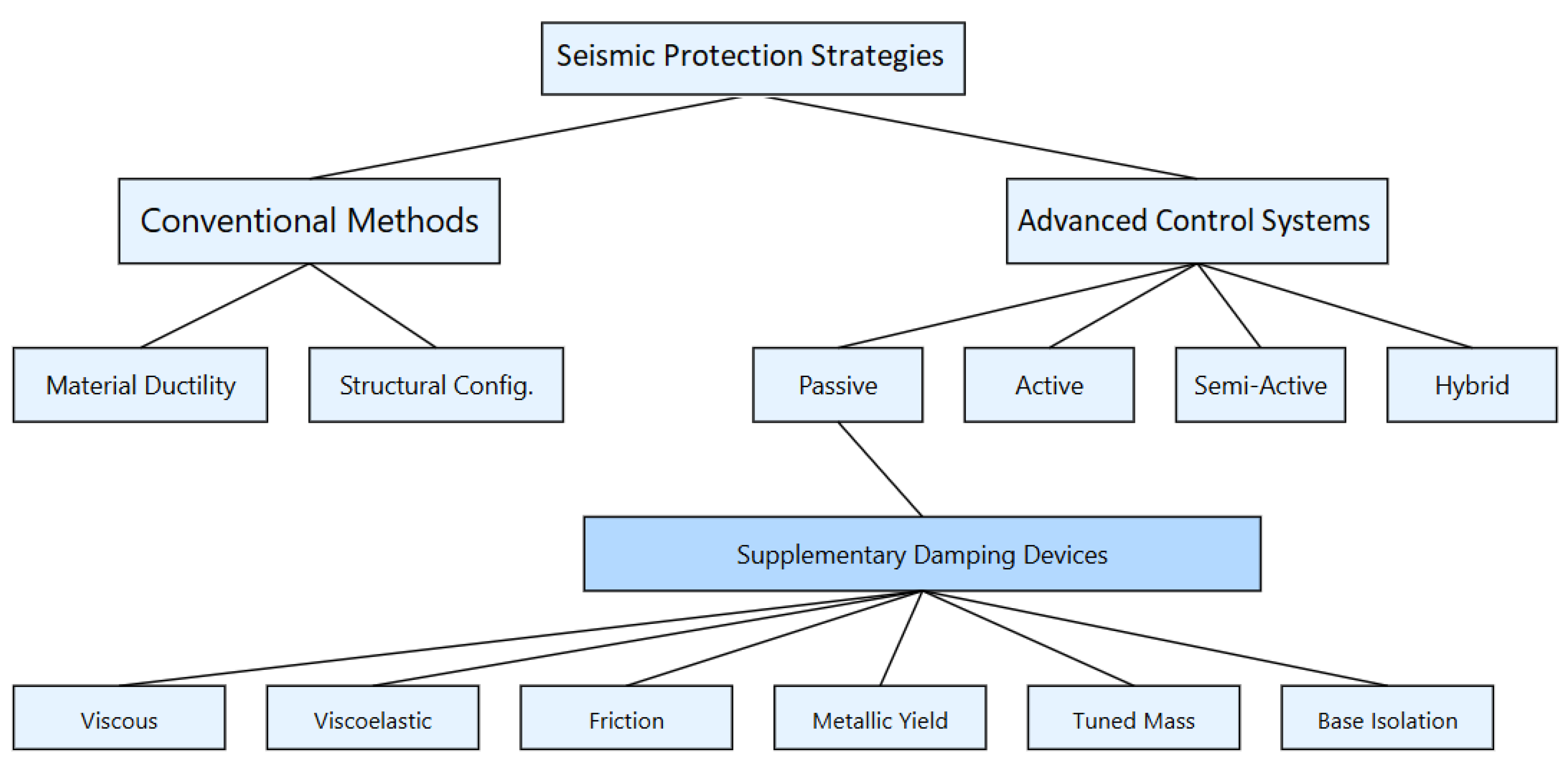

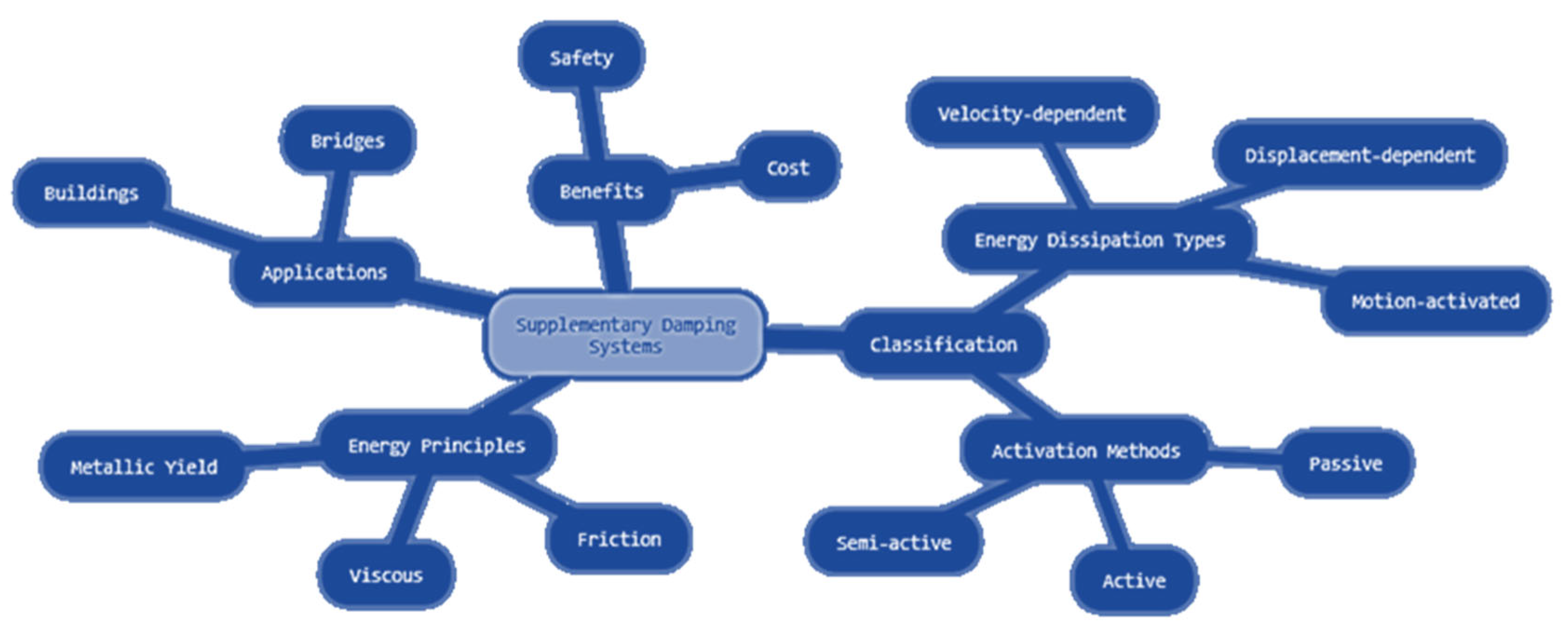
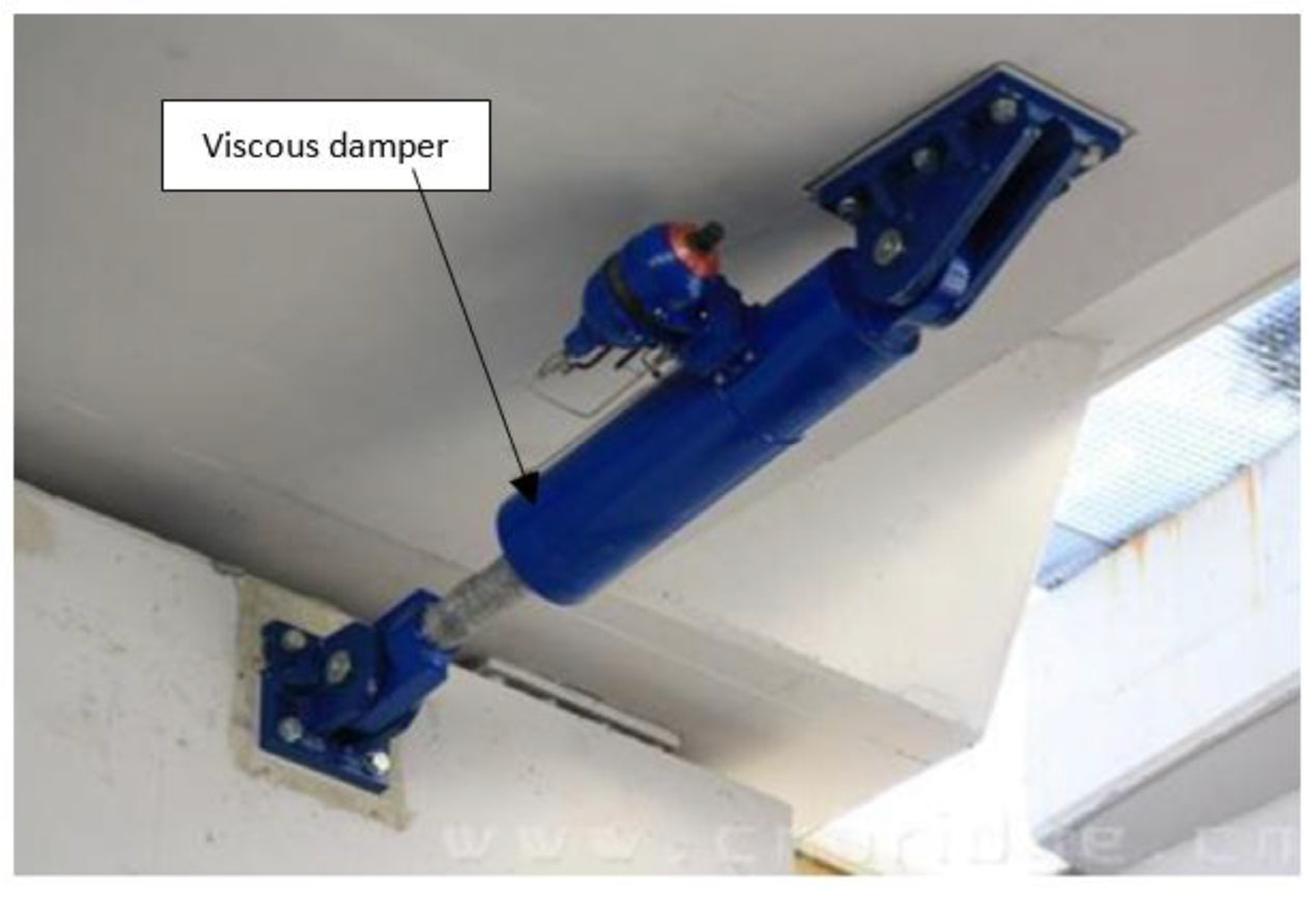
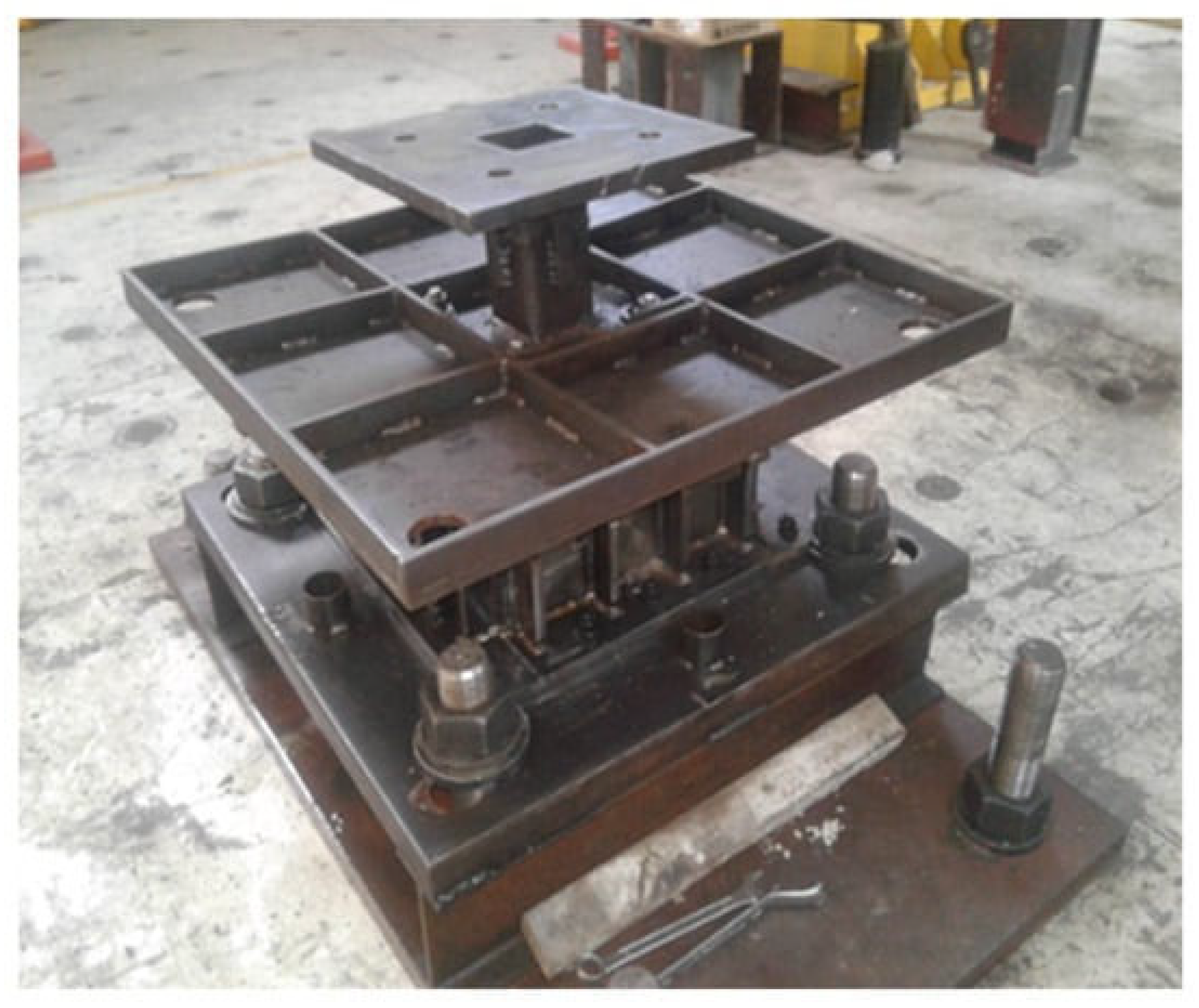


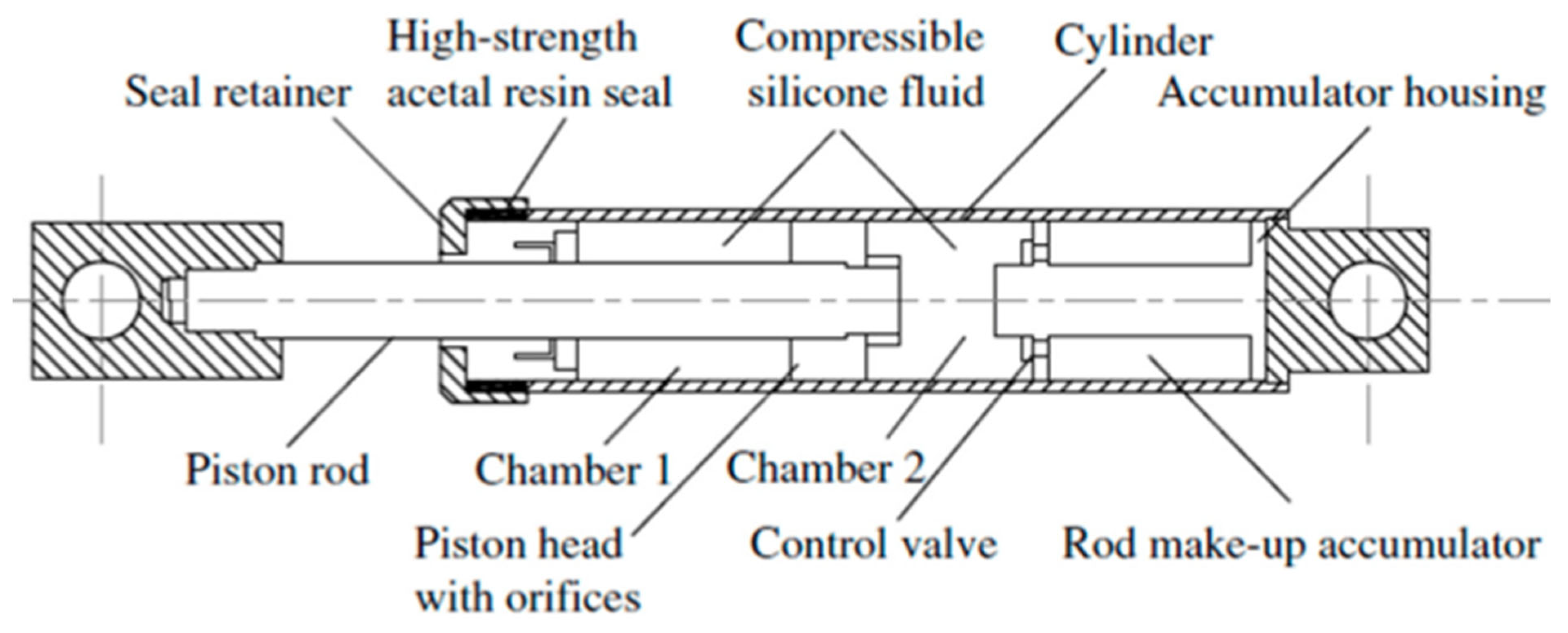
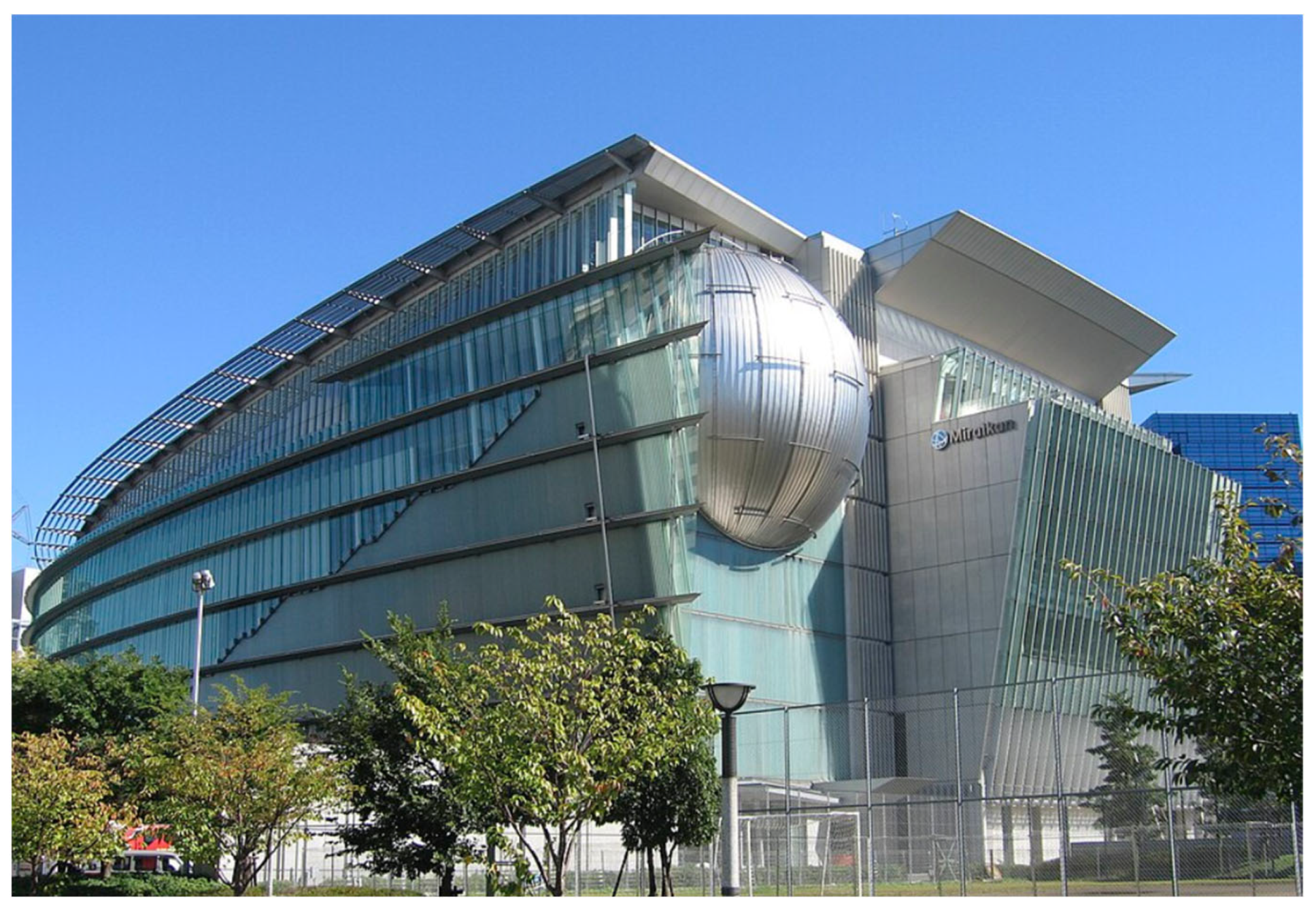
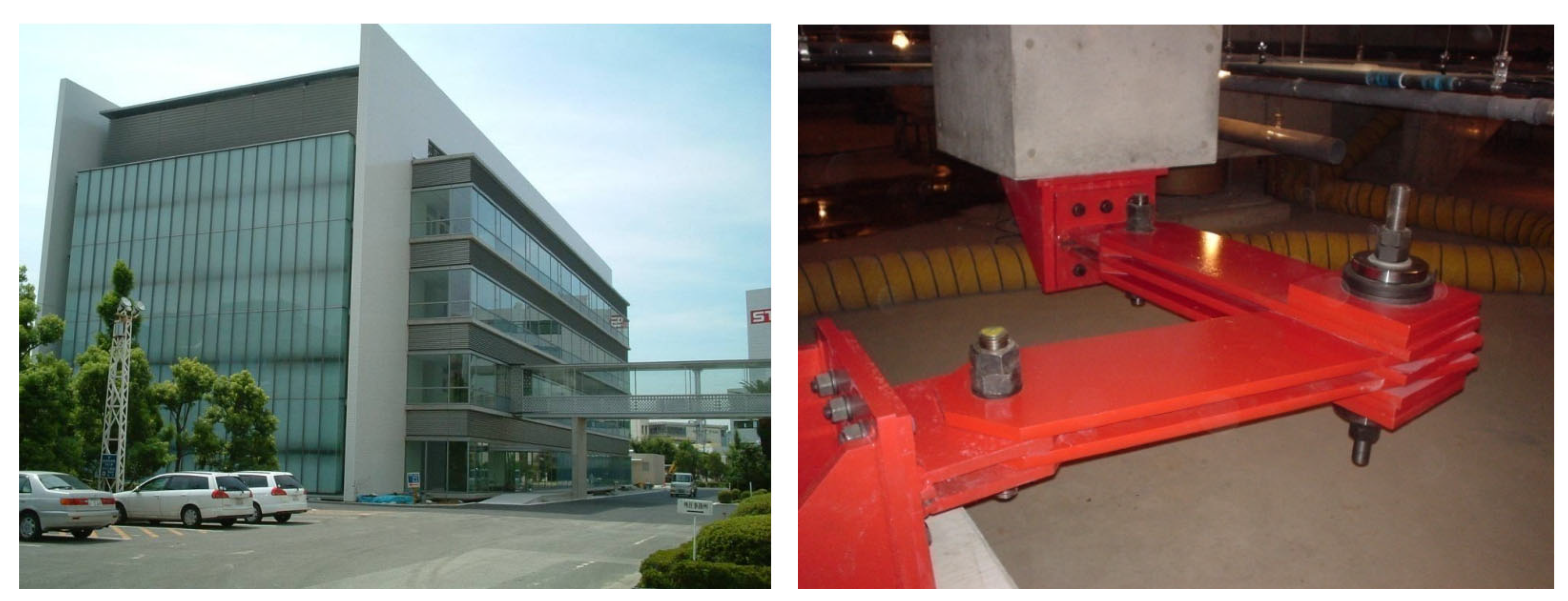
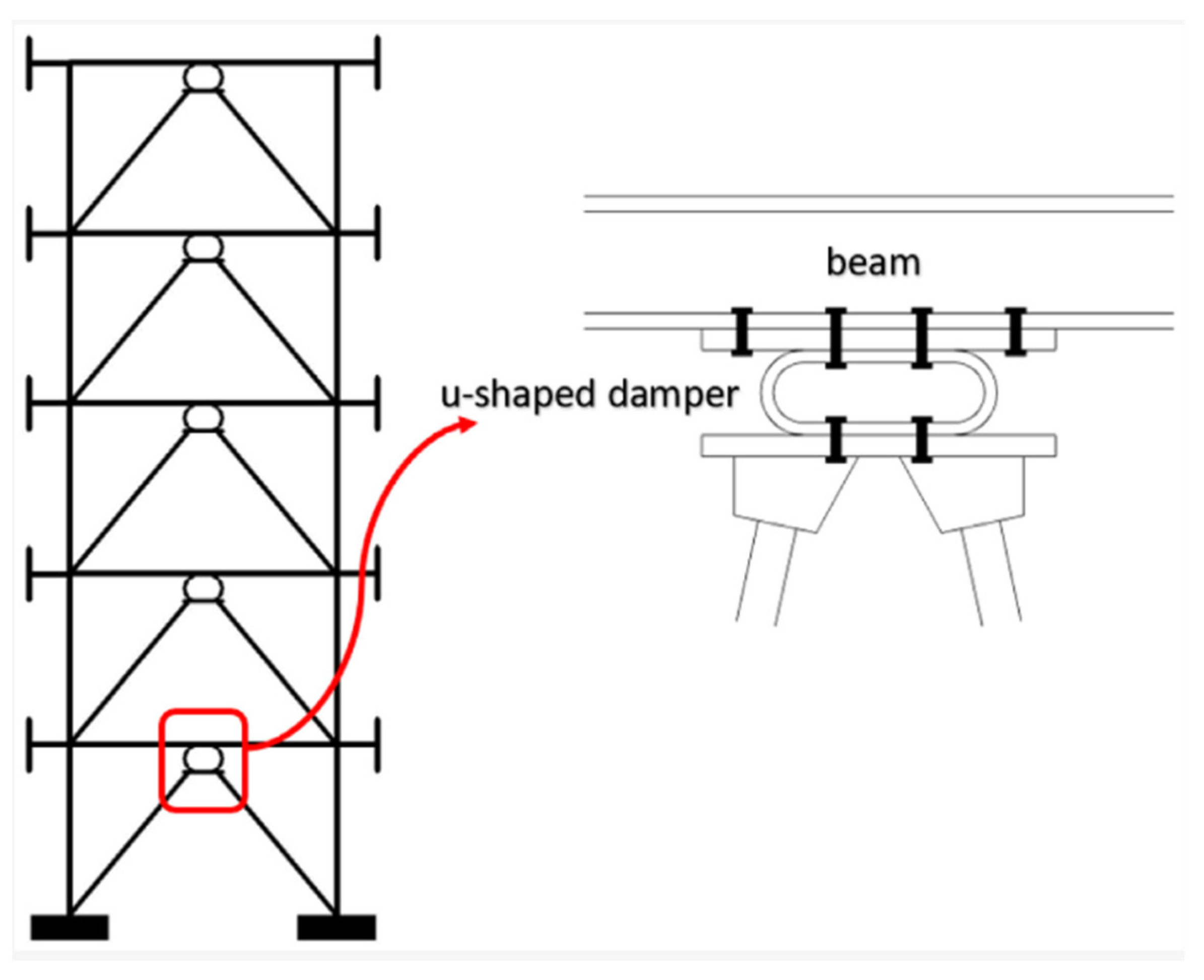
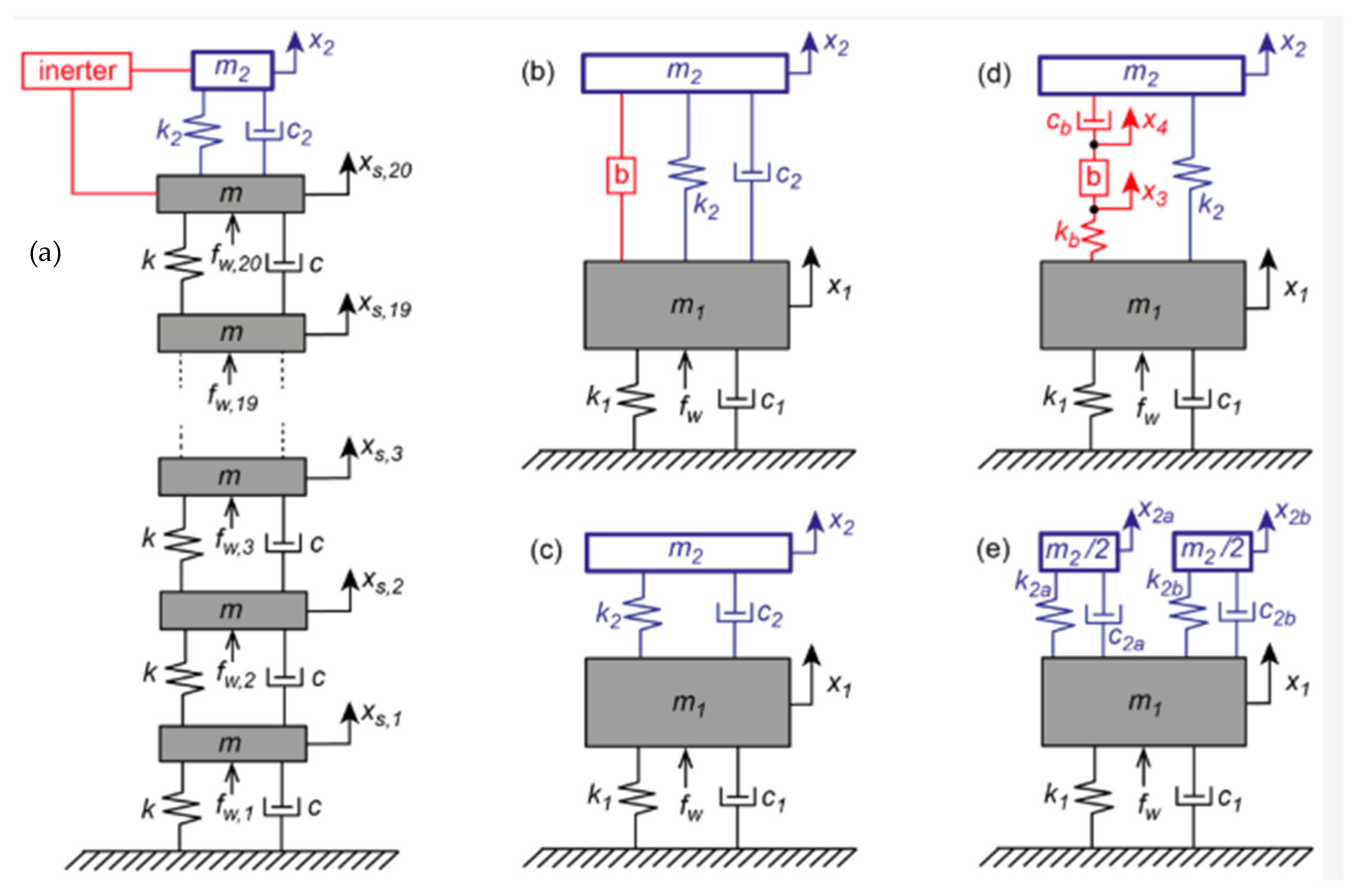
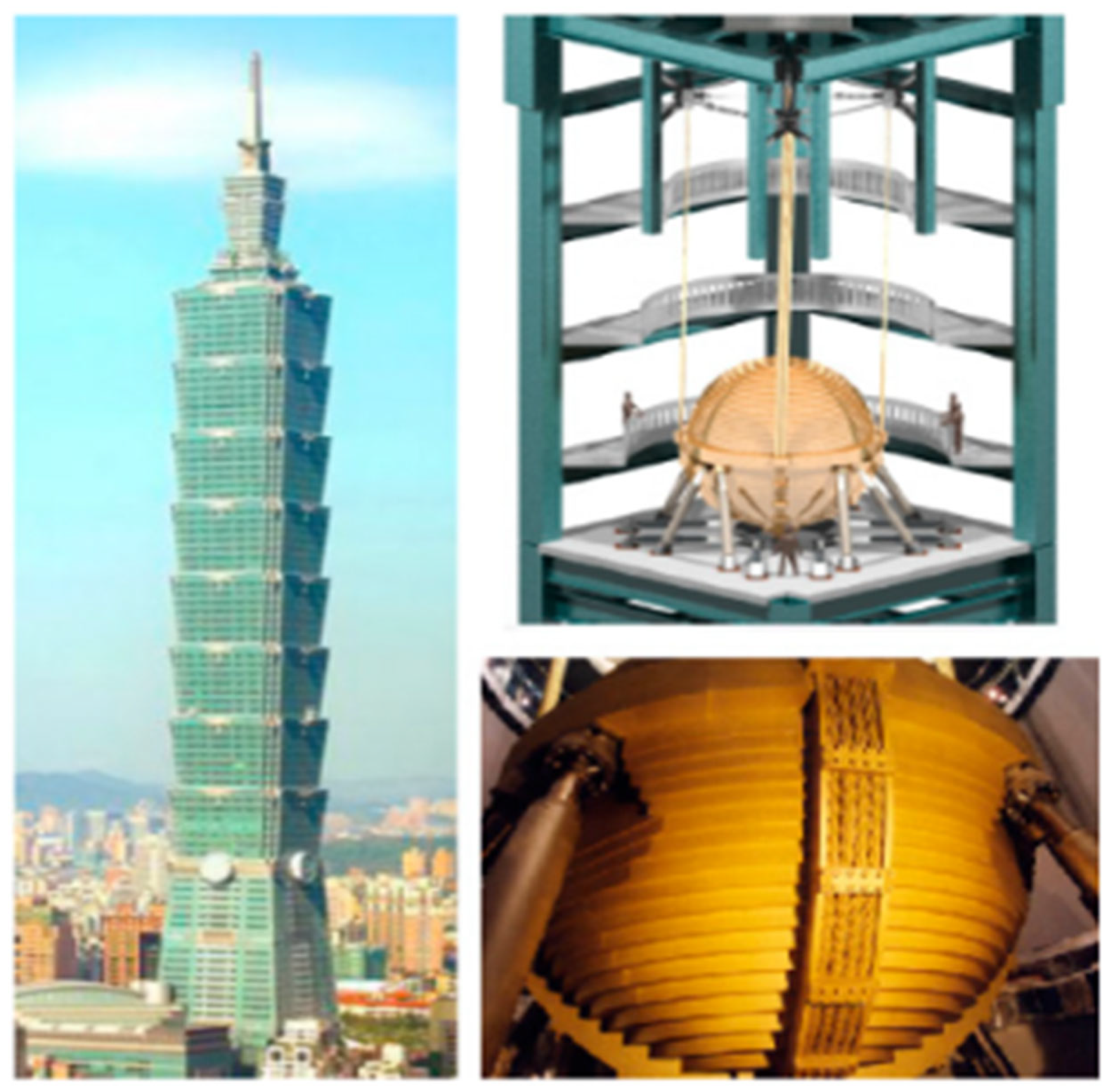

| Damper Type | Energy Dissipation Mechanism | Key Characteristics | Primary Applications | Advantages | Limitations | Detailed Discussion |
|---|---|---|---|---|---|---|
| Viscous Dampers | Velocity–dependent fluid flow |
|
|
|
| Section 3.1 |
| Viscoelastic Dampers | Material deformation |
|
|
|
| Section 3.2 |
| Friction Dampers | Surface friction |
|
|
|
| Section 3.3 |
| Metallic Yield Dampers | Material yielding |
|
|
|
| Section 3.4 |
| Tuned Mass Dampers | Inertial forces |
|
|
|
| Section 3.5 |
| Base isolation | Motion reduction |
|
|
|
| Section 3.6 |
Disclaimer/Publisher’s Note: The statements, opinions and data contained in all publications are solely those of the individual author(s) and contributor(s) and not of MDPI and/or the editor(s). MDPI and/or the editor(s) disclaim responsibility for any injury to people or property resulting from any ideas, methods, instructions or products referred to in the content. |
© 2025 by the authors. Licensee MDPI, Basel, Switzerland. This article is an open access article distributed under the terms and conditions of the Creative Commons Attribution (CC BY) license (https://creativecommons.org/licenses/by/4.0/).
Share and Cite
Katsimpini, P.; Papagiannopoulos, G.; Hatzigeorgiou, G. A Thorough Examination of Innovative Supplementary Dampers Aimed at Enhancing the Seismic Behavior of Structural Systems. Appl. Sci. 2025, 15, 1226. https://doi.org/10.3390/app15031226
Katsimpini P, Papagiannopoulos G, Hatzigeorgiou G. A Thorough Examination of Innovative Supplementary Dampers Aimed at Enhancing the Seismic Behavior of Structural Systems. Applied Sciences. 2025; 15(3):1226. https://doi.org/10.3390/app15031226
Chicago/Turabian StyleKatsimpini, Panagiota, George Papagiannopoulos, and George Hatzigeorgiou. 2025. "A Thorough Examination of Innovative Supplementary Dampers Aimed at Enhancing the Seismic Behavior of Structural Systems" Applied Sciences 15, no. 3: 1226. https://doi.org/10.3390/app15031226
APA StyleKatsimpini, P., Papagiannopoulos, G., & Hatzigeorgiou, G. (2025). A Thorough Examination of Innovative Supplementary Dampers Aimed at Enhancing the Seismic Behavior of Structural Systems. Applied Sciences, 15(3), 1226. https://doi.org/10.3390/app15031226









